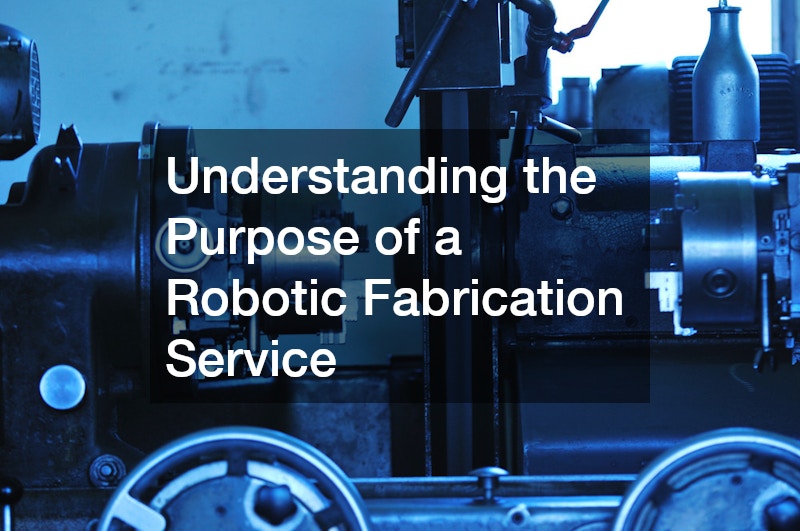Robotic fabrication services represent a pivotal shift in industrial capabilities, blending advanced technology with practical application. Their relevance spans across sectors, becoming an indispensable part of modern production processes. In this article, we explore the purpose of a robotic fabrication service.
What is a Robotic Fabrication Service?
Definition and Basic Concepts
A robotic fabrication service is a system that integrates robots with production processes to enhance precision and efficiency. At its core, it leverages automation and robotics for a streamlined fabrication workflow.
Fundamentally, these services automate complex manufacturing tasks, reducing the reliance on manual labor. This shift allows for the execution of intricate designs with unparalleled accuracy.
By employing robotic systems, industries can maintain consistent quality and significantly improve throughput. The resulting impact is a reduction in error rates and waste, optimizing the use of materials and resources.
History and Evolution
The evolution of robotic fabrication services dates back to the introduction of the first industrial robots in the 1960s. Key milestones include advancements in computer-aided design (CAD) and automation technologies.
Over the decades, technological advancements fueled the sophistication of robotic systems, enhancing their versatility across applications. Initially limited to simple repetitive tasks, robots now tackle sophisticated production challenges.
In recent years, innovations such as AI and machine learning have further enriched robotic capabilities, resulting in intelligent and adaptive systems. As a result, robotic fabrication services are now integral to industries like manufacturing, automotive, and construction.
How Does Robotic Fabrication Work?
Core Technologies
Robotic fabrication is fundamentally powered by advanced automation systems, robotics, and computer-aided design (CAD). Each component plays a crucial role in ensuring precision and agility in production processes.
The integration of robotics provides the mechanical dexterity required for complex tasks, while automation systems ensure continuous operation. CAD software bridges the design and production phases by providing the detailed blueprints necessary for robotic execution.
This synergy between technologies enables the translation of digital designs into tangible products. As technological developments continue, the capabilities of robotic fabrication expand, allowing for more complex and diverse applications.
Processes and Workflow
Robotic fabrication processes typically commence with the detailed design phase, utilizing CAD systems. These designs are then converted into machine-readable instructions for robotic execution.
Once programmed, robotic systems meticulously follow these instructions to manufacture parts with high precision and speed. This workflow minimizes human intervention, reducing potential errors and improving efficiency.
The final production stage involves quality assurance, where robotic systems can be tasked with inspection processes. Thanks to integrated sensing technologies, robots can evaluate product consistency and adherence to specifications.
What are the Benefits of Using Robotic Fabrication Services?
Efficiency and Precision
Robotic fabrication services significantly enhance production efficiency by automating time-consuming and precision-demanding tasks. This automation ensures that operations are conducted rapidly and consistently.
The precision of robotic systems reduces errors and defects, achieving superior product quality. Consequently, industries can maintain consistent standards, vital for consumer satisfaction and regulatory compliance.
By streamlining production processes, robotic fabrication allows for quick adjustments to manufacturing parameters, supporting custom orders and innovation. This adaptability is crucial in today’s fast-paced market environment.
Cost-effectiveness and Scalability
The cost-effectiveness of robotic fabrication services is evident in reduced labor costs and minimized waste. Automation allows for the efficient use of materials, translating into significant cost savings.
Moreover, robotic systems facilitate scalability, enabling industries to adjust production volumes effortlessly. This scalability is essential for meeting fluctuating market demands and supporting business growth.
Although the initial investment in robotic systems can be substantial, the long-term benefits justify the expenditure. Industries can realize improved profitability through optimized operations and resource management.
In Which Industries is Robotic Fabrication Most Impactful?
Manufacturing and Automotive
In the manufacturing and automotive sectors, robotic fabrication has revolutionized production lines by enhancing speed and precision. These industries benefit significantly from automated assembly and quality assurance processes.
Robotic fabrication supports complex tasks such as welding and painting, essential in automotive production. The precision of robots ensures consistent quality and reliability in vehicle manufacturing.
Additionally, robots can manage heavy and repetitive tasks, reducing workplace injuries and improving working conditions. The optimization of manufacturing processes is crucial in maintaining competitiveness in the global market.
Construction and Architecture
Robotic fabrication is transforming the construction and architecture sectors by enabling innovative building techniques. Automation supports the creation of complex architectural forms that were previously challenging with traditional methods.
In construction, robots assist in bricklaying, 3D printing, and concrete pouring, ensuring speed and precision. These technologies are playing a pivotal role in addressing housing shortages through the rapid construction of durable structures.
The architecture sector benefits from robotic capabilities in creating adaptive and sustainable designs. As the demand for green buildings grows, robotics will be central to achieving ecologically sound architectural solutions.
What are the Challenges and Limitations of Robotic Fabrication?
Technical Barriers
Despite its advantages, the adoption of robotic fabrication is not without technical challenges. Calibration and programming complexities require specialized expertise and time, limiting accessibility for some businesses.
Interoperability between different robotic systems and legacy technologies also presents obstacles. Ensuring seamless integration necessitates ongoing innovation and standardization efforts within the industry.
Moreover, the reliability of robotic systems can be affected by technical glitches, leading to potential production delays. Maintenance and troubleshooting of sophisticated robotic systems are areas that require continual development.
Economic and Environmental Concerns
The economic implications of deploying robotic fabrication technology include substantial upfront investment costs. Small to medium-sized enterprises may find these costs prohibitive without appropriate financial support mechanisms.
From an environmental perspective, the energy consumption of robotic systems and the disposal of obsolete units pose significant challenges. As robotic utilization expands, sustainable practices in energy use and recycling need to be prioritized.
Despite these concerns, the potential environmental benefits of reduced waste and resource efficiency cannot be overlooked. The focus on environmentally conscious robotic systems will be vital in future development initiatives.
.



